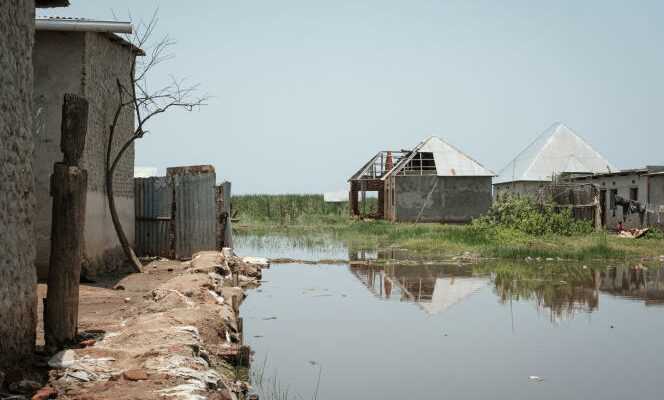To not miss any African news, subscribe to the newsletter of “World Africa” from this link. Every Saturday at 6 a.m., find a week of news and debates covered by the editorial staff of the “World Africa”.
Amissa Irakoze has always known the vagaries of Lake Tanganyika: the regular floods that sometimes touched his home in Gatumba, in northwestern Burundi, and the ebbs that warded off danger. She had never believed that the waters could threaten her ten children.
One day in April 2020, when she returned from her daily work in the fields, she nevertheless discovered her house submerged by the lake, the level of which is rising against a backdrop of climate change. “I shouted: ‘My children, my children, my children!’ »remembers this single mother, mimicking a gesture of despair. “The children were swept away, but people who can swim rescued them (…) and they brought them back to me”, she continues. All were saved.
Amissa tells her story from Kinyinya II camp, located a few kilometers behind Gatumba, which hosts more than 2,300 people displaced by the floods. During the day, a blazing sun crushes this succession of white tents branded IOM, the UN’s International Organization for Migration, and gives way in the evening to a damp and biting cold. In each aisle, dozens of children turn in circles.
Before, “We farmed, we did jobs that helped us survive, but since we came here we haven’t done anything”says a few hundred meters further Lea Nyabenda, who also arrived two years ago. ” Life [est] miserable, the accommodation and the lack of food worry me. Sleeping in such a place when we had a nice big house…”regrets this 40-year-old woman, also a mother of ten children.
A neighborhood that has become a swamp
Lea agrees to go back to her old home in Gatumba, a city that has been developing in all directions in recent decades, boosted by trade with the nearby Democratic Republic of Congo. Even the areas adjoining the waves, yet unbuildable, have seen neighborhoods grow.
Mushasha, the district of Lea, is today a swamp where alternate arms of lakes overgrown with tall grass and houses – some miraculously intact, others abandoned, even completely in ruins.
“This is where my house was”she lets go, stopping in front of a mound of earth and pieces of wood. “There were two bedrooms, there a bedroom, there another one and that part was the living room”. “I avoid coming here, for fear of feeling the tension rising in me. »
Ghostly, the neighborhood has only a handful of inhabitants. The damage goes well beyond just homes. “There are schools that have been destroyed, businesses (…). There are also fields, crops that have been flooded”details on the spot Geoffrey Kirenga, country director of the NGO Save the Children, which helps displaced families and those who have chosen to stay.
Climate change and pollution
Some 65% of those displaced in Gatumba are children. Many no longer have access to school and some have started working to feed their families. “Some children start fishing, which is dangerous: it is not protected and it exposes them to physical injuries”, he adds, glancing worriedly at the waters inhabited in this area by hippos and crocodiles. Save the Children anticipates a deterioration of the situation this year, as the rainy season is currently beginning in Burundi.
The country, densely populated and classified by the World Bank as the poorest in the world in GDP per capita, has experienced several waves of exodus due to the conflicts that have shaken it. Today, the threat is changing.
Nearly 85% of the 113,000 internally displaced people are due to natural disasters, according to the IOM, which points out that Burundi is one of the twenty countries most vulnerable to climate change. The meteorological records of recent years thus show an intensification of rainfall, torrential in particular, note the experts.
In addition to elevations “cyclical” of the historically observed water level, the rise in water is explained by the pollution of the many rivers that flow into Tanganyika, underlines Albert Mbonerane, former Minister of the Environment and ardent defender of the ecosystem of the lake.
This pollution threatens to block the only flow path, on the Congolese side, of the second largest lake in Africa. In fact, the waves have not ebbed or almost since 2020. “When I see all the solid waste, everything that’s thrown into these rivers (…). The lake is throwing up to say: “But what do you want me to do?” »he points.
To the east of Gatumba, the capital Bujumbura stretches its districts, restaurants, port and airport around the lake. Plots are flooded and half of a four-lane that ran along the shore is now closed, recalling the constant threat hanging over Burundi’s largest city. “Sometimes when we talk about the environment, it seems like it’s stories being told so [que] the realities are there”laments Albert Mbonerane.
